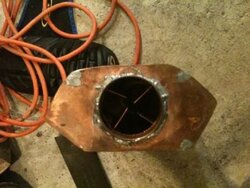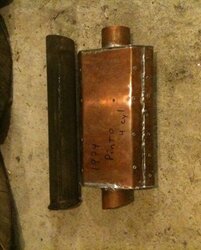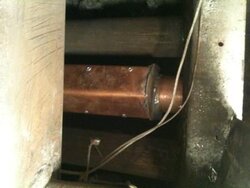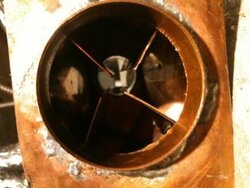Ever wonder just how much heat the air inlet tubes recover from the exiting exhaust of a Seton type bioler?
About a year ago I set up some thermocouples at various places in my Seton to study its operation and see if there were ways to improve the efficiency. One of these thermocouples was placed in one of the inlet tubes about an inch from the inside end where the tube rests in the hole in the ceramic "wall". The temperature in the tube was observed periodically for about a year. The results were not particularly impressive. The air is warmed from room temperature(60-70degF) up to 105-135). It takes a real hot fire (about 500deg+ stack) to get to 135F. It was sort of disappointing to see so little of the "prewarming" of the comsbustion air that is talked about in the literature for these things. It doesn't seem to matter too much how clean the inlet tubes are either. They may pick up a little performance after a cleaning, but not more than maybe 5degF. On average, the exhaust is going up the stack at 450F after only warming the exhaust by about 60degF.
This looked like an opportunity for improvement. So after about 20 drawings, many beers, and many modifications, the end result was the "'74 Pinto" you see in the pics. (My brother was kind enough to fab the prototype for me, so I'm sort of obligated to share his humor!). It's been in the boiler over a month now and the solder (yes, ordinary solder!) is holding up pretty well so far. It looked fine after its first dusting last week. The first picture (if they attach -I've never done pics before) should be a top view of the new hx installed in the boiler between the ordinary inlet tubes. The second pic is a side by side view of the Pinto and the stock hx tube. The third pic is an end view that shows the end dimensions and the interior baffles in the hx. The inside baffles may not be performing up to their potential because they're just riveted in, (no solder) so the contact with the outer shell may not be great.
This Hx shows a higher and wider performance range relative to the original inlet tube. It will run 160F (on a cool fire, or on startup) all the way up to 220F on a hot fire with 500F exhaust. It's averaging about 180-185F overall vs 120-125F for the stock muffler. It doesn't appear to impede the air flow, although I have not gotten any actual measurements to verify this. If it lasts a year without corroding or the solder melting, I may make a couple more.
About a year ago I set up some thermocouples at various places in my Seton to study its operation and see if there were ways to improve the efficiency. One of these thermocouples was placed in one of the inlet tubes about an inch from the inside end where the tube rests in the hole in the ceramic "wall". The temperature in the tube was observed periodically for about a year. The results were not particularly impressive. The air is warmed from room temperature(60-70degF) up to 105-135). It takes a real hot fire (about 500deg+ stack) to get to 135F. It was sort of disappointing to see so little of the "prewarming" of the comsbustion air that is talked about in the literature for these things. It doesn't seem to matter too much how clean the inlet tubes are either. They may pick up a little performance after a cleaning, but not more than maybe 5degF. On average, the exhaust is going up the stack at 450F after only warming the exhaust by about 60degF.
This looked like an opportunity for improvement. So after about 20 drawings, many beers, and many modifications, the end result was the "'74 Pinto" you see in the pics. (My brother was kind enough to fab the prototype for me, so I'm sort of obligated to share his humor!). It's been in the boiler over a month now and the solder (yes, ordinary solder!) is holding up pretty well so far. It looked fine after its first dusting last week. The first picture (if they attach -I've never done pics before) should be a top view of the new hx installed in the boiler between the ordinary inlet tubes. The second pic is a side by side view of the Pinto and the stock hx tube. The third pic is an end view that shows the end dimensions and the interior baffles in the hx. The inside baffles may not be performing up to their potential because they're just riveted in, (no solder) so the contact with the outer shell may not be great.
This Hx shows a higher and wider performance range relative to the original inlet tube. It will run 160F (on a cool fire, or on startup) all the way up to 220F on a hot fire with 500F exhaust. It's averaging about 180-185F overall vs 120-125F for the stock muffler. It doesn't appear to impede the air flow, although I have not gotten any actual measurements to verify this. If it lasts a year without corroding or the solder melting, I may make a couple more.






 Congratulations Mole on your ingenuity. I really think you are on to something & your kindness in sharing will make all us Seton types a lot happier.
Congratulations Mole on your ingenuity. I really think you are on to something & your kindness in sharing will make all us Seton types a lot happier. !
!